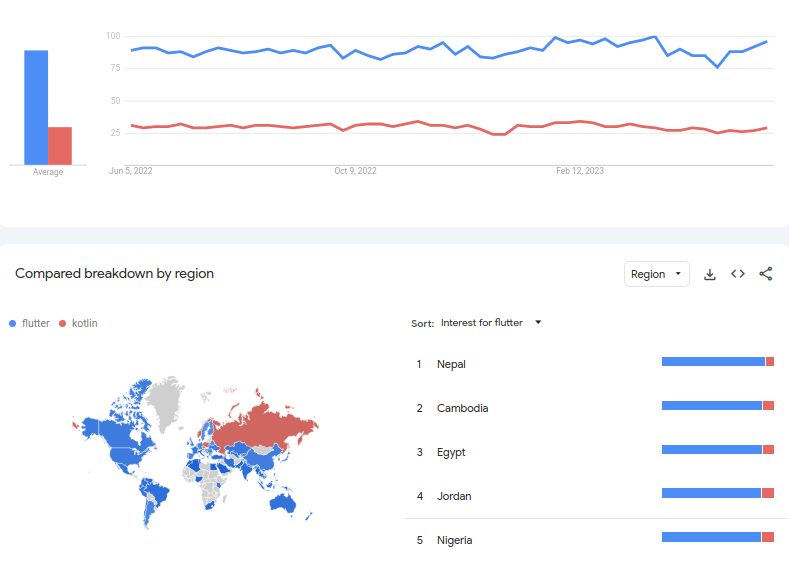Here’s a comparison between Flutter and Kotlin
| Feature | Flutter | Kotlin |
|---|---|---|
| Platform | Cross-platform (iOS, Android, web, desktop) | Primarily used for Android development |
| Language | Dart | Kotlin |
| User Interface | Widget-based UI development with customizable components | XML-based layout with flexibility using ConstraintLayout |
| Performance | Native-like performance with compiled code | Excellent performance on Android |
| Development Speed | Hot reload for faster development cycles | Incremental compilation for fast iterations |
| Code Reusability | Single codebase for multiple platforms | Code reuse limited to Android platforms |
| Community Support | Growing community with active development and resources | Strong community support with extensive resources and libraries |
| Learning Curve | Moderate learning curve for Dart and Flutter | Familiar syntax for Java developers transitioning to Kotlin |
| Ecosystem | Expanding ecosystem with plugins and packages | Mature ecosystem with extensive libraries and frameworks |
| Tooling and IDE | Flutter offers a rich set of tools and IDE integration | Strong tooling and IDE support with Android Studio |
| Adoption | Increasing popularity and adoption in mobile development | Widely adopted in the Android development community |
| Native Integration | Platform channels for accessing native features | Seamless integration with Android native code |
| UI/UX Flexibility | Flexible UI with custom animations and transitions | Adheres to Material Design guidelines |
| Popularity | Rapidly gaining popularity among developers | Established popularity in Android development |
It’s important to note that the choice between Flutter and Kotlin depends on your previous skills , your specific project requirements, target platforms, team expertise, and other factors. Both Flutter and Kotlin have their strengths and are well-suited for different scenarios.
Prior skills required for Kotlin and Flutter development:
Prior skills required for Kotlin and Flutter development:
| Skills | Kotlin Development | Flutter Development |
|---|---|---|
| Programming Language | Strong understanding of Java and its libraries | Proficiency in Dart programming language |
| Object-Oriented Programming | Solid foundation in OOP concepts | Familiarity with Flutter’s widget-based architecture |
| Android Development | Knowledge of Android SDK and Android-specific concepts | Understanding of cross-platform development |
| Kotlin Language | Proficiency in Kotlin syntax and features | Understanding of Dart syntax and functionality |
| Design Patterns | Awareness of common design patterns (MVVM, MVP, etc.) | Familiarity with Material Design guidelines |
| IDE and Development Tools | Experience with Android Studio IDE | Proficiency in using Flutter SDK and development tools |
| UI/UX Design | Basic understanding of UI/UX design principles | Knowledge of creating visually appealing interfaces |
| Architecture Components | Knowledge of Android architecture components | Familiarity with Flutter’s state management options |
| Asynchronous Programming | Understanding of coroutines and asynchronous programming | Familiarity with Dart’s asynchronous programming |
Note: There may be additional skills required based on the specific project, such as database management, network requests, or backend integration.
Flutter vs Kotlin by Goolge Trends (June 2022 -June 2023)

Approx Salary Range of Flutter Developer and Kotlin Developer[1]
| Developer Level | Flutter Developer Salary Range | Kotlin Developer Salary Range |
|---|---|---|
| Entry-level | $55,000 – $85,000 per year | $60,000 – $90,000 per year |
| Mid-level | $85,000 – $115,000 per year | $90,000 – $120,000 per year |
| Senior | $115,000 – $150,000+ per year | $120,000 – $150,000+ per year |
Please note that these salary ranges are approximate and can vary based on various factors such as location, experience, company size, and industry.
References:
[1] indeed.com , naukri.com



